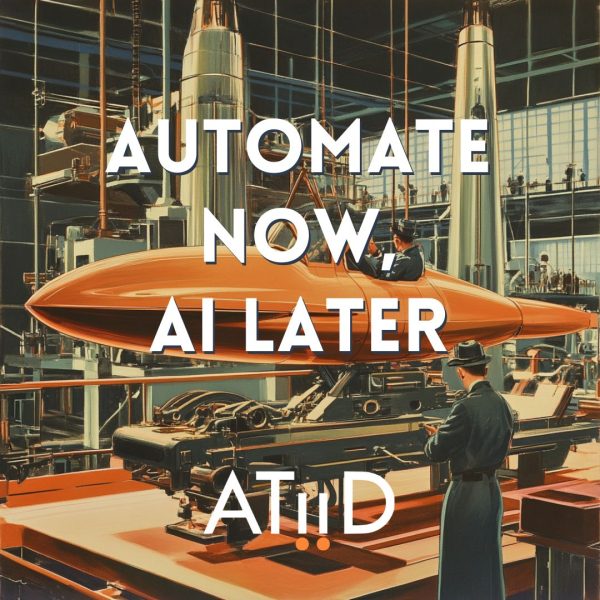Automate Now, AI Later
In the rapidly evolving technological landscape, businesses are inundated with discussions about artificial intelligence (AI), particularly large language models (LLMs) like ChatGPT. While these advancements are indeed transformative, it’s crucial for organizations to understand that the journey to effective AI integration begins with a solid foundation in automation, particularly through machine learning (ML).

Machine Learning vs. LLMs: Know the Difference
Before we dive deeper, it’s important to understand that ML and LLMs aren’t interchangeable.
- Machine Learning, helps automate repetitive, rules-based tasks by finding patterns in data. It powers everything from predictive maintenance to fraud detection and logistics optimization.
- Large Language Models, on the other hand, are a type of generative AI that can understand and produce human-like language, enabling new forms of content creation, customer service, and decision support.
Machine learning makes your business run more efficiently. LLMs make your business think more creatively. You’ll eventually want both—but you’ll need the automation foundation first.
Forbes: The Vital Difference Between Machine Learning and Generative AI
The Evolution of Automation
Automation has a rich history that stretches back thousands of years. Ancient civilizations developed water clocks, windmills, and irrigation systems that automated basic processes without human intervention. The Industrial Revolution (1760-1840) marked a pivotal moment with the introduction of steam power and mechanized production, fundamentally changing manufacturing and transportation.
In the early 20th century, automation entered factories through assembly lines and standardized parts, epitomized by Henry Ford’s revolutionary manufacturing techniques. The 1950s and 60s saw the emergence of electronic automation, with the development of early computers and industrial robots. Programmable Logic Controllers (PLCs) in the 1970s allowed for more flexible and sophisticated control systems.
The digital revolution of the 1980s and 90s brought software automation to the forefront, with Enterprise Resource Planning (ERP) systems and business process automation transforming how organizations managed information. The internet era accelerated this trend with web-based automation tools and cloud computing.
Today’s automation landscape has evolved dramatically with the rise of machine learning in the early 2000s, robotic process automation (RPA) in the 2010s, and now the emergence of generative AI, representing the continuous human quest to create systems that can perform increasingly complex tasks with minimal intervention.
Automate Now to Be Ready Later
If your business is already using ML to automate key operations, you’re setting yourself up for a plug-and-play experience when it’s time to bring in LLMs. These businesses will be able to integrate new AI capabilities in a matter of months—not years—because the processes, data structures, and employee roles are already optimized.
Companies that haven’t automated? They’ll need to rebuild from the ground up, delaying any meaningful AI integration and falling far behind their competitors.
McKinsey: Operationalizing Machine Learning in Business Processes
Human Jobs Will Change—And That’s a Good Thing
Automation doesn’t eliminate jobs—it changes them. As machine learning takes over repetitive tasks, humans will take on higher-value roles in strategy, creativity, communication, and oversight. But that won’t happen by accident.
Companies need to rethink their workforce strategy now. This means designing roles that work alongside AI, not in conflict with it. When LLMs enter the picture, these retooled teams will be ready to adopt the technology confidently and use it to its fullest potential.
Taking the Next Steps
To future-proof your organization and stay ahead of the curve:
Assess Current Processes Look for areas where machine learning can eliminate inefficiencies and free up employee time.
Invest in Infrastructure Build the data and systems backbone needed to support both ML and LLM capabilities.
Re-tool Your Workforce Redesign job roles to focus on strategic thinking, creativity, and collaboration with AI tools. Train your team to work alongside technology—not be replaced by it.
Cultivate In-House Talent Start building internal AI and automation capabilities now through training, hiring, and partnerships.
Explore LLM Pilot Projects Stay informed on how LLMs are being used in your industry and run small, low-risk experiments to see where they fit.
Lay the Groundwork Now, Reap the Rewards Later
Businesses that automate with machine learning today are giving themselves a head start for when LLMs reshape the future of work. By building strong processes and rethinking the role of humans in an AI-enhanced workplace, you’ll be ready to act quickly and win the adoption race when the next big breakthrough lands.
At ATiiD, we help businesses design automation and AI strategies that prepare them for what’s now—and what’s next.
